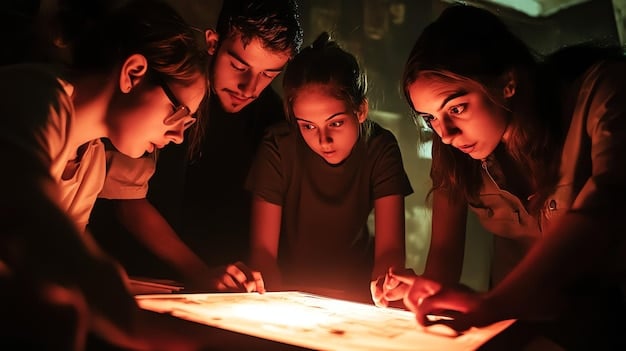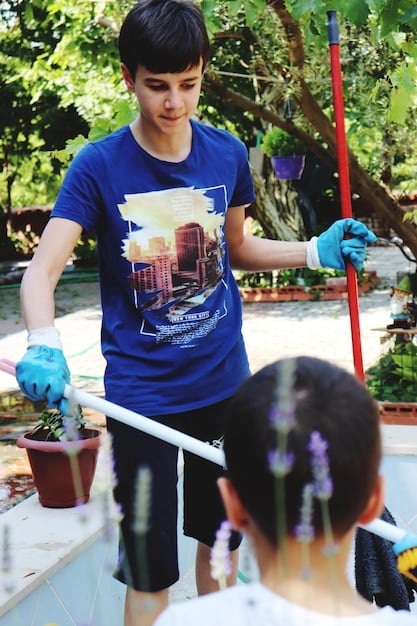Future of K-Drama Acting: 5 Emerging Trends in 2025

The future of K-drama acting is poised for significant shifts by 2025, driven by global audience demands, technological advancements, and evolving storytelling, shaping how actors perform and engage with narratives.
The global phenomenon of K-dramas continues its meteoric rise, captivating audiences worldwide with compelling narratives and talented performers. As the industry evolves at an unprecedented pace, understanding the shifts shaping its future is crucial for actors, producers, and fans alike. In this landscape, The Future of K-Drama Acting: 5 Emerging Trends Shaping the Industry in 2025 promises a dynamic and innovative era. What can we expect to see from the new generation of K-drama stars, and how will their craft adapt to these exciting changes?
The Rise of Authentic, Nuanced Portrayals
In recent years, K-dramas have moved beyond stereotypical character representations, embracing more complex and multi-faceted roles. This shift reflects a global audience’s demand for realism and relatability, moving away from idealized archetypes towards characters with genuine flaws, struggles, and triumphs. By 2025, this trend will deepen significantly, requiring actors to deliver performances rooted in profound authenticity and nuanced emotional depth.
Actors are increasingly challenged to explore the unspoken aspects of their characters, bringing subtle gestures, facial expressions, and vocal inflections to the forefront. This emphasis on internal motivation over external theatrics allows for a more profound connection with viewers, who are eager to see themselves reflected in the stories they consume. The era of one-dimensional heroes and villains is rapidly fading, making way for protagonists and antagonists whose moral compasses are often blurred, much like in real life.
Deep Dive into Psychological Complexity
The exploration of psychological landscapes within characters is becoming paramount. Writers are crafting narratives that delve into mental health, trauma, and complex family dynamics, compelling actors to research and embody these intricate states with sensitivity and precision. This requires more than just memorizing lines; it demands an actor’s full immersion into a character’s psyche.
- Method Acting Adaptation: K-drama actors are increasingly employing techniques akin to method acting, deeply exploring their characters’ backgrounds and motivations.
- Emotional Vulnerability: The ability to portray raw, vulnerable emotions without resorting to over-the-top melodrama is highly valued, creating more believable performances.
- Subtle Expression: Mastering micro-expressions and body language to convey internal turmoil or quiet joy will differentiate leading actors.
This trend also implies a greater responsibility for actors to accurately and respectfully represent sensitive themes, often working with consultants to ensure authenticity. The days of simply looking good on screen are being replaced by the necessity of feeling and portraying deeply. As K-dramas continue to tackle more mature and complex themes, the depth required from actors will only increase, pushing them to new heights of their craft.
The increasing interconnectedness of global cultures means that stories resonating universally often feature characters grappling with struggles that transcend geographical boundaries. Actors who can tap into these universal human experiences, while still maintaining the distinctive cultural nuances of their roles, will find exceptional success. This move towards authentic portrayal elevates K-drama from simple entertainment to a powerful medium for cultural exchange and empathy.
Technological Integration: AI, Virtual Production, and Digital Humans
As we approach 2025, technology’s role in K-drama production is no longer supplementary; it’s becoming integral. Advances in artificial intelligence (AI), virtual production (VP), and the burgeoning field of digital human creation are set to revolutionize how actors perform, interact with their environments, and even how they are cast. This technological wave offers both unprecedented opportunities and unique challenges for the acting profession, pushing the boundaries of traditional filmmaking.

Virtual production, often utilizing large LED volumes, allows actors to perform within dynamically rendered digital environments. This eliminates the need for extensive green screen work and provides a more immersive experience for the actors, as they can react to their surroundings in real-time. This real-time rendering also reduces post-production time and costs, making complex visual effects more accessible.
AI in Casting and Performance Analysis
AI algorithms are beginning to play a role in casting, analyzing vast data sets of actors’ past performances, vocal range, and even facial symmetry to suggest optimal matches for specific roles. While human discretion will undoubtedly remain paramount, AI can significantly streamline the initial selection process, identifying talent that might otherwise be overlooked. Furthermore, AI tools can provide actors with subtle feedback on their performances, analyzing nuances in expression and delivery to help refine their craft.
- Automated Feedback: AI can analyze an actor’s performance for consistency, emotional accuracy, and delivery, providing actionable insights for improvement.
- Character Deepfakes: While controversial, deepfake technology could potentially allow actors to perform in multiple projects simultaneously, though ethical guidelines will be crucial.
- Digital Doubles: High-fidelity digital scans of actors can create realistic “digital doubles” for stunts, dangerous scenes, or even to de-age/re-age actors, extending their careers or range.
The emergence of highly realistic digital humans (avatars) presents a fascinating, albeit contentious, future. These digital entities, powered by AI and advanced animation, could potentially handle background roles, crowd scenes, or even act as supporting characters, reducing the need for large human casts. However, the artistry and emotional depth unique to human actors will likely remain irreplaceable for leading roles, shifting the emphasis towards performances that truly differentiate human emotion from digital mimicry.
Actors will need to become more comfortable interacting with virtual elements, understanding the nuances of performing against projections rather than physical sets. This necessitates a new skill set, blending traditional acting techniques with an understanding of digital space and real-time visual effects. The integration of technology will transform K-drama sets into dynamic, interactive hubs where storytelling meets cutting-edge innovation.
Diversification of Genres and International Collaborations
K-dramas were once primarily known for their romantic comedies and melodramas. While these genres remain popular, the industry is witnessing a significant diversification into a broader array of categories, including sci-fi, horror, historical epics with fantastical elements, and gritty thrillers. This expansion is largely fueled by the global audience’s increasingly sophisticated tastes and the desire for fresh, unconventional narratives. By 2025, this trend will not only broaden the scope of stories told but also open doors for more international collaborations, enriching the K-drama landscape even further.
This genre diversification demands greater versatility from actors. A performer might transition from a lighthearted romantic lead to a complex anti-hero in a dark thriller, showcasing a wide range of acting talent. Such shifts challenge actors to continuously adapt their craft, delve into new character types, and embody emotions beyond their traditional comfort zones. This dynamic environment fosters immense growth for individual actors and raises the overall quality of performances across the industry.
Strategic International Co-Productions
The global success of K-dramas has naturally led to increased interest from international production companies. By 2025, we can expect to see more co-productions with studios from Hollywood, Europe, and other Asian countries. These collaborations bring together diverse creative teams, financial resources, and, crucially, a blend of acting styles and cultural perspectives. For K-drama actors, this means potential exposure to different directing methodologies, larger budgets, and an even wider global stage.
- Language Proficiency: Actors with proficiency in English or other major languages will have a significant advantage in securing roles in international co-productions.
- Cross-Cultural Nuances: Understanding and adapting to different acting conventions and cultural communication styles will be key for successful collaborations.
- Global Storytelling: Projects will increasingly focus on universal themes that resonate worldwide, albeit with a distinct K-drama flair.
These international partnerships are not just about market expansion; they are about creative cross-pollination. The exchange of ideas, techniques, and storytelling traditions will undoubtedly lead to groundbreaking content that transcends typical genre boundaries. For actors, this presents an exciting opportunity to learn from veterans of different film industries and to bring new influences into their performances, further refining their unique style.
The diversification of genres also translates into more experimental narratives that might blend elements of different categories, creating hybrid shows that defy easy categorization. This pushes actors to deliver performances that can navigate rapid tonal shifts and complex narrative structures, becoming agile and adaptable performers in an ever-evolving industry. The future promises a vibrant tapestry of stories, each demanding a unique and compelling performance.
The Emphasis on Voice Acting and Multi-Platform Storytelling
Traditionally, K-drama acting has focused primarily on visual performance, given the medium’s inherent nature. However, as the entertainment ecosystem expands beyond linear television into webtoons, audio dramas, animated series, and interactive content, the importance of voice acting is rapidly escalating. By 2025, actors will increasingly need to hone their vocal craft, recognizing that their voice alone can convey character, emotion, and narrative depth across various platforms. This trend also signifies a move towards stories that exist fluidly across multiple entertainment formats.
The rise of high-quality audio dramas, often featuring popular K-drama stars, has highlighted the power of vocal performance. In these productions, actors must rely solely on their voice to convey the full spectrum of emotions, character nuances, and situational context. This demands precise control over tone, pitch, pace, and vocal texture, allowing listeners to visualize the scene and connect with the characters without visual cues. It’s a return to the roots of storytelling, where the spoken word held supreme power.
Expanding Beyond Visual Media
Multi-platform storytelling means intellectual properties (IPs) are increasingly developed with the intention of existing in various forms from the outset. A popular webtoon might be adapted into a K-drama, which then spawns an audio drama, a video game, or even an animated series. For actors, this implies the potential for reprising their roles across different media, or perhaps taking on entirely new roles in companion content, all requiring distinct performance skills.
- Vocal Versatility: Actors will need to master a range of voices, accents, and emotional deliveries for diverse character types in audio and animation.
- Physicality in Voice: Learning to embody physical actions and emotions through vocal cues, even when not physically acting, becomes crucial.
- Studio Comfort: Familiarity and comfort with recording studio environments, microphone techniques, and isolated performance will be essential.
The convergence of media also positions K-drama actors to become more holistic performers. Those who can seamlessly transition between live-action, voice-over work for animation, and potentially even motion-capture performances for video games, will find themselves in high demand. This professional agility allows actors to diversify their portfolios and extend their creative reach beyond the constraints of a single medium.
Moreover, as K-pop idols increasingly venture into acting, their pre-existing vocal training and experience with diverse musical styles may give them an edge in embracing voice acting challenges. This cross-pollination of talent from music to acting, and now increasingly to voice work, underscores the evolving demands on performers to be multi-faceted artists ready for any creative call.
Sustainability and Ethical Acting Practices
As global awareness of environmental and social issues grows, the entertainment industry is coming under increasing scrutiny for its ecological footprint and labor practices. By 2025, sustainability and ethical considerations will not just be buzzwords but integrated practices within K-drama production. For actors, this translates into a heightened awareness of their role in promoting responsible production, advocating for fair labor, and contributing to a more sustainable industry. This shift aligns with broader societal values and offers K-dramas an opportunity to lead by example.
Sustainable production practices encompass everything from reducing waste on set and using renewable energy to sourcing ethical materials for costumes and props. Actors, as influential figures, can advocate for these practices and participate in initiatives aimed at minimizing the environmental impact of filmmaking. Their public support can encourage studios to adopt greener policies and prompt fans to consider their own consumption habits, magnifying the positive impact.
Advocacy for Fair Labor and Mental Health
The intense schedules and demanding nature of K-drama productions have historically raised concerns about actor well-being and fair labor practices. By 2025, there will be an even greater emphasis on creating healthier and more equitable working environments. This includes regulating working hours, ensuring adequate breaks, providing mental health support, and establishing transparent contracting between actors and production companies.
- Well-being Programs: Greater availability of mental health support and counseling for actors dealing with demanding roles and workloads.
- Fair Contracts: Advocacy for standardized contracts that protect actors’ rights, compensation, and intellectual property.
- Eco-Conscious Sets: Participation in initiatives to reduce waste, conserve energy, and promote recycling on film sets.
Actors themselves are increasingly speaking out about the importance of work-life balance and mental health, normalizing conversations around these critical issues. This open dialogue helps to dismantle the culture of overwork that can sometimes pervade the industry. As role models, actors demonstrating self-care and advocating for their own well-being send a powerful message to their fan base and the broader industry about the importance of human dignity.

Furthermore, the ethical representation of diverse characters and narratives will continue to be a priority. Actors will be expected to approach their roles with sensitivity, avoiding stereotypes and contributing to stories that promote inclusivity and respect. This responsibility extends beyond the screen, influencing their public persona and how they engage with social causes. The future of K-drama acting is intrinsically linked to its ability to evolve as a responsible and conscientious global force.
| Key Trend | Brief Description |
|---|---|
| 🎭 Authentic Acting | Focus on nuanced, psychologically deep portrayals reflecting real-world complexities. |
| 🤖 Tech Integration | Increased use of AI, virtual production, and digital humans in filmmaking. |
| 🌍 Global Collaboration | Diversification of genres and more international co-productions. |
| 🗣️ Voice Acting & Multi-Platform | Greater emphasis on vocal performance for audio dramas and diverse content formats. |
Frequently Asked Questions about K-Drama Acting Trends
▼
Actors will push beyond caricatures, focusing on psychological depth and nuanced emotional portrayals. This means less overt theatricality and more subtle expressions, requiring deeper character study and emotional intelligence to connect with a globally diverse audience seeking relatable and complex human experiences.
▼
AI may aid in casting and performance analysis, offering feedback. Virtual production, using LED volumes, will allow actors to perform in real-time digital environments, reducing green screen reliance. Actors will need to adapt to interacting with virtual elements, blending traditional skills with new technical comfort on innovative sets.
▼
Actors will need increased versatility, transitioning across genres like sci-fi, horror, and historical dramas. International co-productions demand language proficiency and an understanding of cross-cultural acting nuances. This expands their global exposure and enriches their craft through diverse creative exchanges, fostering significant professional growth.
▼
The rise of multi-platform storytelling, including audio dramas, webtoons, and animated series, elevates voice acting. Actors must convey full emotional range and character depth solely through vocal performance, adapting their tone, pitch, and pace. This expands their professional scope beyond visual media, creating versatile performers.
▼
It means actors will advocate for greener production methods, waste reduction on set, and ethical materials. They will also champion fair labor practices, regulated working hours, and mental health support within the demanding industry. This involves promoting socially responsible behavior, both on and off-screen, aligning with global values.
Conclusion
The K-drama industry is in a perpetual state of evolution, driven by its unique blend of artistic integrity and global ambition. By 2025, the trends of authentic portrayals, technological integration, genre diversification, vocal mastery, and ethical practices will collectively redefine the landscape of K-drama acting. These shifts demand a new level of versatility, depth, and social consciousness from actors, transforming them into multi-faceted artists capable of captivating audiences across an increasingly complex and interconnected media ecosystem. The future of K-drama acting is not just about what stories are told, but how they are brought to life with profound artistry and a commitment to innovation, securing its place as a global cultural powerhouse.





